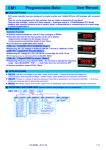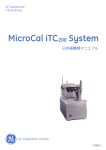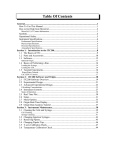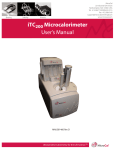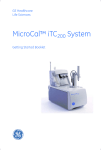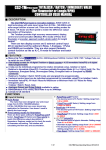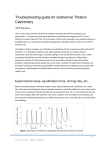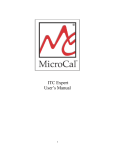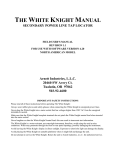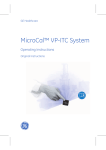Download CMI ITC-200 Standard Protocol - Center for Macromolecular
Transcript
Center for Macromolecular Interactions MicroCal ITC-200 for Isothermal Titration Calorimetry General Care and Maintenance • The instrument should be left ON at all times • Wash the instrument thoroughly before and after every run • Treat the syringe with care, it's easy to break and expensive • Report problems immediately in the booking system: https://ppms.us/hms-cmi • Refer to the Microcal ITC-200 Getting Started Guide and User Manual for more information • Perform water-in-water titrations at the end of the day to check the system Start-up Sequence 1. Before you start, book time on the PPMS calendar 2. Login to the computer using your PPMS credentials (eCommons ID and password) 3. The ITC-200 instrument should be left ON at all times. If not, turn it on using the power switch on the back. 4. Start the MicroCal ITC-200 software. 5. After system initialization, check that all systems are working and that the red light on the front of the instrument is on. 6. Make sure that wash station bottles and methanol are at least ½ full. a. Methanol bottle should contain 100% Methanol b. Water and Buffer bottles should both contain Milli-Q water 7. Empty the waste bottle if more than ½ full. 8. Fill the reference cell with water, if it hasn't been filled in more than a week 9. In ITC-200 software, select Instrument Controls Tab 10. Run Cell Water Rinse (long) 11. Run Syringe Wash (long) a. follow on screen directions for attaching the fill port adapter b. **do not over-tighten fill port adapter** Standard Protocol 1. Prepare samples and reagents (see CMI_ITC200_sample_prep_guidelines document for tips) 2. In ITC-200 software, select Setup Tab a. enter Data File path. eg. C:\ITC200\Data\PInameLab\YourName b. enter Setup File Path (optional) c. Current User should be Default User (do not create user profiles) 3. In ITC-200 software, select Advanced Experimental Design Tab 4. Enter Experimental Parameters: Total # Injections 19 Cell Temperature (C°) 25 Reference Power (µcal/s) 6-7 (if ΔH is unknown) Initial Delay (sec) 60 CMI • Harvard Medical School • 45 Shattuck St. • LHRRB 211A • Boston, MA 02115 [email protected] • 617-432-5004 • Kelly Arnett, PhD, Director Center for Macromolecular Interactions Syringe concentration (mM) Cell concentration (mM) Stirring Speed (RPM) 1000 Data File Name Feedback Mode/Gain high 5. Enter Injection Parameters: first inj. remaining injections Volume (µl) 0.4 2 Duration (sec) 0.8 4 (2X injection volume) Spacing (sec) 150 150 Filter Period (sec) 5 5 6. In ITC-200 software, select Instrument Controls Tab 7. Run Syringe Fill Method a. place a tube with ≥60 µl syringe sample in the tube holder at load position b. follow on screen directions for filling syringe c. Don't forget to remove the wash module attachment after filling 8. Manually wash cell with buffer matched to sample buffer, at least 3 times using Hamilton syringe 9. Manually fill cell with cell sample, being very careful not to introduce air bubbles: a. fill Hamilton syringe with about 300 µl sample for cell, remove air bubbles b. carefully insert syringe into sample cell until it touches the bottom c. lift syringe up 1-2 mm d. slowly fill cell with sample (until sample emerges from top) e. gently aspirate and dispense about 50 µl sample to dislodge any air bubbles f. remove the syringe while ejecting g. place the tip of the syringe on the ledge at top of metal cell stem and remove excess solution 10. When syringe fill is complete, disconnect the fill port adapter a. move pipette to rest position b. loosen retaining nut c. remove fill port adapter d. gently tighten retaining nut 11. Place pipette into cell port 12. Click start to begin assay a. in 5-10 min the differential power (DP) should stabilize near the set reference power (±1 µcal/sec ) b. if it doesn't stabilize at all or near the reference power, check that the sample cell and the reference cell are filled or clean the cell again 13. Select Real Time Plot to view raw data 14. After every run, clean the cell and syringe again before the next titration 15. At the end of the day, follow the NEW Shutdown Procedure (below, and posted at the instrument) CMI • Harvard Medical School • 45 Shattuck St. • LHRRB 211A • Boston, MA 02115 [email protected] • 617-432-5004 • Kelly Arnett, PhD, Director Center for Macromolecular Interactions New ITC-200 Shutdown Procedure 1. Clean the instrument. a. Clean the cell using the Cell Water Rinse (long) b. Clean the syringe using the Syringe Wash (Long) protocol c. If you suspect precipitation in the cell, wash the cell with detergent: i) follow the Detergent Soak and Rinse protocol, with 10-20% Contrad 70 ii) Remove the detergent manually from the cell (using the Hamilton syringe) iii) Wash the cell using the wash module 2. Run a water-in-water titration: a. Fill the syringe with filtered, degassed water b. Fill the cell with filtered, degassed water c. Detach the wash module from the syringe d. In ITC-200 software, go to Setup Tab i) enter Data File path: C:\ITC200\Data\1_CMI_WaterTitrations ii) enter Setup File Path: C:\ITC200\Setup\1_CMI_WaterTitrations e. In ITC-200 software, select Advanced Experimental Design Tab f. Load the file Water_15cycle_RP6.inj or set up the experiment with the following parameters i) 15 injections, 25C, Reference Power 6µcal/sec, Initial Delay 60 sec ii) Data File Name: YYYYMMDDwaterINITIALS (eg. 20150519waterKLA) iii) 2 µl injections, 120 sec spacings g. Start the water-in-water titration (runtime ~30 min) 3. During the run, check that : i) the differential power is within 1ucal/sec of the set reference power. ii) Check that the heats of dilution are minimal and uniform iii) If these fails, repeat from Step 1 until the instrument is clean 4. Run the Syringe Wash (Long or Short) protocol 5. Empty the cell 6. Sign in the paper logbook 7. Logoff from PPMS! rates are based on booked and real time usage 8. Report Problems in the PPMS booking system https://ppms.us/hms-cmi Contact [email protected] with questions last edited: 2015-10-30 CMI • Harvard Medical School • 45 Shattuck St. • LHRRB 211A • Boston, MA 02115 [email protected] • 617-432-5004 • Kelly Arnett, PhD, Director



